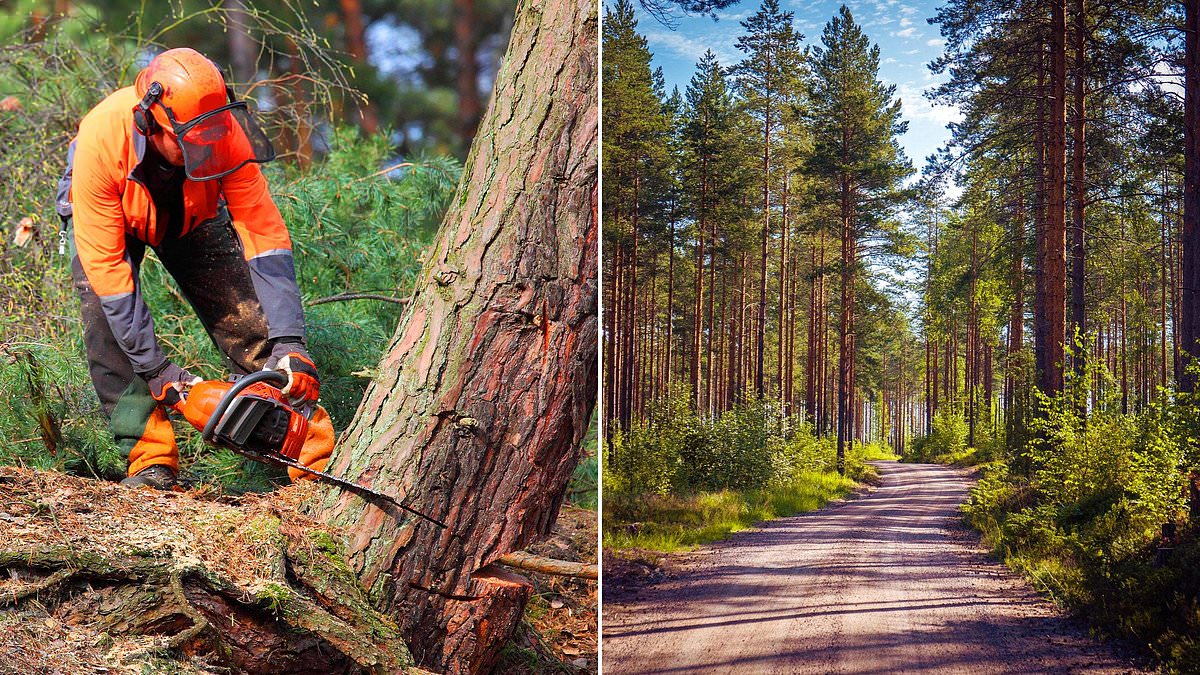Copyright dailymail

Can investing in a forest really grow your wealth and help the planet? Trees are less vulnerable to economic headwinds - but aren't a short-term play By HARVEY DORSET, REPORTER, THIS IS MONEY Updated: 07:00 GMT, 6 November 2025 Sustainable and ESG-led investing has lost some of its lustre in recent years, with many investors losing confidence in green-labelled investments amid underperformance and fears of greenwashing. Fewer than half of investors say they now consider ESG credentials when making investments, according to 2024 data from the Association of Investment Companies. Figures from investment platform Bestinvest indicate that ESG funds have seen their performance slump in recent years, constituting 44 of 137 underperforming 'dog' funds. However, the Earth's environmental problems aren't going away. The past summer was the warmest on record for the UK, and damage to the planet continues through pollution, deforestation, loss of biodiversity and over-consumption. Many investors have a desire to see that their investments also bring about positive changes to the world as well as financial return, but simply don't know where to turn to find the balance between doing good and seeing their finances benefit too. So away from their obvious environmental benefits, can trees also be used as a viable way to diversify your portfolio and deliver growth at the same time? Hedge: Forestry is positively correlated with inflation, meaning that there is security that the investment will provide returns in line with the rate of price growth 'A useful hedge' The key strong returns is to build an investment portfolio that is diversified across regions and sectors. The idea behind this is to be able to withstand the impact of price fluctuations, and allow your portfolio to weather any storm thrown at it. But oh, have there been storms. Indices like the S&P 500 and FTSE 100 plummeted on the back of Trump's 'liberation day' tariff announcements earlier this year, as the US president slapped levies on countries across the world. While it is worth noting that even forestry funds were impacted - Ishares Global Timber & Forestry ETF took a 12.48 per cent hit in the week following Trump's announcements - for the most part forestry as an asset class has a lack of correlation to the whims of the world's equities markets. RELATED ARTICLES Woke funds have gone to the dogs: Bestinvest reveals ESG has... How to tariff-proof your investments: These six UK stocks... Share this article HOW THIS IS MONEY CAN HELP Best investment platforms: How to choose the right one for you Anthony Crosbie Dawson, director of forestry and private clients at Gresham House, says: 'The main investment rationale for an allocation to forestry is portfolio diversification. 'It's uncorrelated to mainstream listed markets, which of course in times of turmoil in listed markets such as we're experiencing at the moment, and high levels of volatility, forestry really demonstrates its diversification attributes.' On top of this, he says, forestry is positively correlated with inflation, meaning that there is security that the investment will provide returns in line with inflation. Xander Mahony, head of forestry investment at Tilhill Forestry, says: 'Commodity prices are also expected to keep up with inflation, providing a useful hedge in an uncertain world.' Whatever else is going on in the world, these trees are in the ground Anthony Crosbie Dawson, Gresham House The other key benefit of forestry investments is that for all the global turmoil, whether that is foreign policy, conflict, or economic downturn, trees will continue to grow unchallenged. Mahony told This is Money: 'It's something of a cliché in forestry but the trees will indeed grow regardless of what the economy or interest rates are doing. Crosbie Dawson agrees. The diversification benefits of forestry, he says, are 'underpinned by the biological growth of the trees.' Gresham House's funds focus on conifers, which are fast growing and have productive end uses. Crosbie Dawson says: 'The trees are putting on, on average, about five per cent annual volume growth, so whatever else is going on in the world these trees are in the ground. 'They're growing, they're immune to whatever tariff might be announced next or whatever might be tweeted next. They aren't subject to the vagaries of social media posts or utterings by central bankers about the possible direction of interest rates.' The life of a tree Trees, by their very nature, are not suitable for a short-term investment. To benefit from the payoff, that is the harvesting of trees once they reach maturity, investors will have to wait decades. FORESIGHT SOLAR: Solar farm fund struggles to keep the lights on - but is fighting back Crosbie Dawson told this is Money: 'Within the UK, we have a short rotation [due to the climate compared to forestry assets further north], but all things are relative, so a short rotation is about 35 to 40 years from when the trees are planted to when they're mature and ready to be harvested.' If you are buying a forest directly, this could mean a long wait – especially if the land has yet to be planted. Mahony says: 'Timing the market is something of a red herring in forestry as the typical investor has a time horizon of decades, which may mean whether you invest today or a year or two from now doesn't make that much difference in 20 or 30 years' time. 'If you have the capital to buy multiple assets, spreading out purchases over a period of years could reduce the risk of buying at a bad time.' Funds like Gresham's own a number of forests of multiple different age classes. Crosbie Dawson says: 'There's no crossover between funds, they all own individual assets within each fund.' The firm's Sustainable Timber and Energy Fund, for example, holds 70 different forests across the country. This not only means that investors will benefit from a consistent cycle of harvesting when forests reach maturity, they can also diversify even further across differing forestry funds. Investors own a share of each forestry asset, meaning that even if the investment manager went out of business, they still own the underlying forest. Time to mature: Gresham House plantations are harvested after a period of 35 to 40 years Timber demand is growing When the trees do reach maturity they are harvested and sold, largely for use in construction. This is a tale as old as time, but Gresham House says demand timber is growing and will continue to do so by around three per cent per year until 2050. Crosbie Dawson says: 'It is driven by three main factors: the increasing global population, the urbanisation of that population and subsequent housing shortage. 'This is a theme throughout the developed world, increasingly one which has an impact on elections and one which politicians are acutely aware of.' In the UK, for example, the Labour Government has promised to deliver 1.5million new homes. The construction of the average UK home requires between 20 and 40 trees, according to figures from Logie Timber. The third trend driving timber demand, he says, is sustainability, which is seeing housebuilders 'replacing carbon Intensive building materials such as concrete and steel with low carbon timber'. He added: 'Further to that, the top of the tree is increasingly being used in packaging to replace plastic.' As bodies like the Forest Stewardship Council set the standards for sustainable forestry, there is a growing expectation that timber should be sourced sustainably from plantations like those owned by Gresham House. Gresham House says it plants more trees than it fells, planting two to three trees for each cut down within around six months of harvesting. 'It makes sense for investors because you are getting started on the next rotations and taking advantage of the capital growth,' Crosbie Dawson says. The biggest benefit for UK-focused funds is that the UK imports around 82 per cent of the timber it uses. 'We're the second-largest net importer of timber in the world after China, which is great for us as domestic growers because we can never grow anything like enough timber to satisfy domestic demand and it also means that we're not exporting anything, so we're not concerned about tariffs on that front either,' Crosbie Dawson added. The continued growth in global population and consumption, as well as ever growing awareness of the environmental issues we face, means the sector looks well-placed to capitalise on increasing demand for sustainable building materials. Income investors back cheap passive funds to save on fees - but are they missing out on returns? How to invest in forestry Investing in forestry can come in wildly different forms. For those looking to invest smaller amounts, there are ETF options available, offered by the likes of Ishares and Invesco. Over the past ten years, the Ishares Global Timber & Forestry ETF has risen almost 43 per cent, though has faced its fair share of downturns during that timeframe. However, the drawback of these ETFs is that they generally offer global exposure, rather than focusing specifically on the UK or another geography. For managed funds though, there is a cost barrier for many retail investors. According to Wealth Club, the minimum investment in forestry funds is £50,000, while Gresham House's funds have a minimum investment of £100,000. Crosbie Dawson says this helps to make forestry more accessible than buying forests outright. 'We're increasing the investor universe that can gain exposure to forestry as an asset class,' he says. Since their inception in 2008, Gresham House's funds have delivered an average annual net return of 11.4 per cent, net of fees and costs. Alternatively, there are firms, like Tilhill, that offer direct forestry investments, which means they will help investors identify a suitable property, whether woodland or land where trees can be planted. Mahony says: 'There are strategies for all budgets, but large-scale forestry investing is typically for those with substantial liquid assets. Quality commercial forests with good economies of scale start at around £500,000.' According to Tilhill, asset values have fallen since the Covid pandemic, and there are more options for investors to choose from. Commercially managed forestry investments come with the added benefit of 100 per cent inheritance tax relief on holdings up to £1million under business property relief, a tax benefit that was slashed to 50 per cent for investors in the AIM market in the Autumn Budget last year. The tax benefits don't end there, as there is no capital gains tax payable on the increase in value of the trees themselves, nor is income tax or corporation tax payable on the sale of the harvested trees, Crosbie Dawson says. DIY INVESTING PLATFORMS Easy investing and ready-made portfolios Hargreaves Lansdown Hargreaves Lansdown Free fund dealing and investment ideas interactive investor interactive investor Flat-fee investing from £4.99 per month InvestEngine InvestEngine Account and trading fee-free ETF investing Trading 212 Trading 212 Free share dealing and no account fee Affiliate links: If you take out a product This is Money may earn a commission. These deals are chosen by our editorial team, as we think they are worth highlighting. This does not affect our editorial independence. Compare the best investing account for you Share or comment on this article: Can investing in a forest really grow your wealth and help the planet? Add comment



